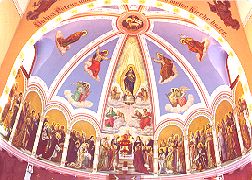
Full Size 68k

Often enough we find that authors and artists prefer a rustic life in comparative seclusion. So it was with Mr. Imhoff. He moved to St. Walburg, Sask. There he purchased land and had built a lovely home and studio. The home has since been enlarged and improved. The studio, where he spent hours and months at his chosen occupation, still stands today, housing many of the paintings he left behind. Mr. Imhoff's son Carl lives in a mobile home nearby, while a grandson lives in the original Imhoff home.
In the course of each year, numerous visitors come to see the paintings in the studio. Hundreds of times people have tried to purchase paintings, but the sons and daughters of Imhoff refuse to sell, preferring to preserve the lovely paintings as a reminder of Mr. Imhoff's industry and talent and skill.
When Mr. Imhoff died he left enough paintings to decorate a dozen large churches. His specialty was church decoration, though he left evidence of skill in portraits of historical personages, or friends, and when he needed a Judas for the scene of the Last Supper or the Crucifixion, the features of another acquaintance were conjured up and reproduced with striking effect. There never was anything cheap to Mr. Imhoff's paintings. He used the finest oils and colors, while for special effects, oils were imported. Mr. Imhoff never used gold or aluminum in imitation of gold or silver effect. Where the effect was to be golden, genuine gold leaf was used. The leaves were so fine and delicate it took at least 10,000 leaves to build up one single inch. Using a small artist's brush, Mr. Imhoff would, with a flick of the wrist, draw up one delicate gold leaf after another, as needed.
For the kind of work Mr. Imhoff did, a considerable structure of scaffolding was necessary, both for the safety and convenience of the artist and any helpers he needed. Usually a carpenter did the structural work. However, at times Mr. Imhoff did a great part of this himself. To watch him work with a hammer and saw was a revelation. He built scaffolding with the facility and skill of a carpenter.
Imhoff did not sell or use all of his paintings during his lifetime, yet, he refused to be inactive. He painted for the love of art. Had he lived twenty years longer, he would surely have used all his paintings in new churches. However, it must be remembered that when Mr. Imhoff came out west, the pioneering days were by no means over, so many of the parishes were still poor. Furthermore, so many of the farmers had no real appreciation of true art and skill of a near genius.
In these days of the present, modern trends, sculptures, paintings, and statues in churches are not so much encouraged as in the past. I do not mean to say that we are on the verge of iconoclasm, yet there is more evidence of a trend toward simplicity. In the days when Mr. Imhoff was producing his best work, the farmer was constantly conscious of his responsibility toward clothing and feeding his family. Bread and butter problems were staring him in the face daily, and he had little inclination to encourage his parish to invest in non-essentials. From an economic and business standpoint, Mr. Imhoff made a mistake in coming to the far northwest, but the good Lord blessed his work. He never became a wealthy man, but his paintings tell us of the wealth of virtue and sterling character of this wonderful man, whom I had the honor and pleasure to know so well.
[ Home ]
Please send comments to Carlton Trail REDA Inc.
![]()
Box 10, Muenster, SK., S0K 2Y0![]()
[ The Humboldt Journal ][Early Humboldt]
[ St. Peter's Abbey | Agriculture | Communities ]
[ Present-day Humboldt and Surrounding Communities ]
[ Language ]
![]()